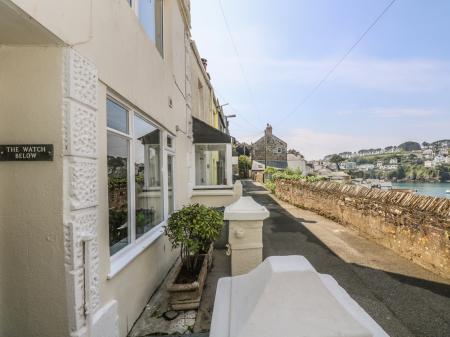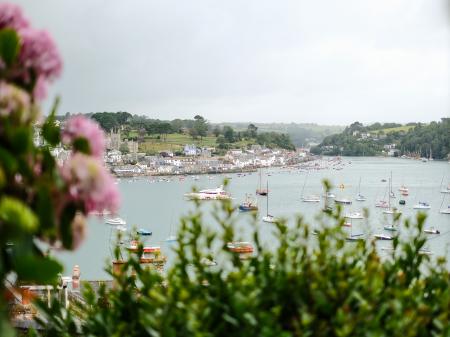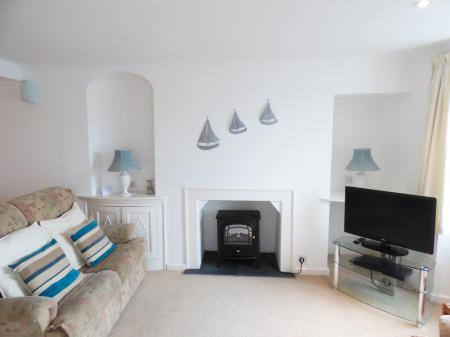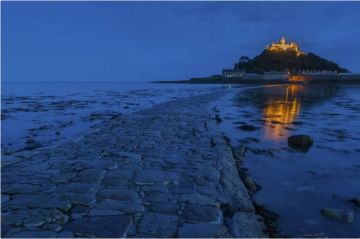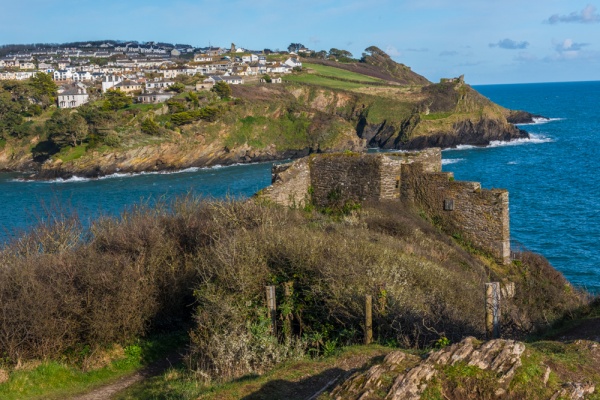
History
Construction could not have been swift, for a map of 1630 shows it with a caption 'half made'. Records show that the man in charge of building the castle was Thomas Treffry, who later designed St Mawes Castle and Pendennis Castle. St Catherine's seems much more rudimentary by comparison to those latter castles, so Treffry must have learned lessons from his first major building project here.

Perhaps 'castle' is too grand a word for what is essentially a small fort. There is only one tower, laid out in a D-shape, defended by a curtain wall extending down the slope of the headland. The tower stands 2 storeys high, with walls 4 1/2 feet thick. Two sets of gunports cover both the harbour and the estuary approaches. The gunports originally served fixed cannons, rather than guns mounted on wheels as you might expect.
There is a lookout on the first floor and a spiral stair to the roof, which must originally have had a parapet. One thing that will be immediately obvious when you view the castle is that there are no quarters for a garrison. It seems that St Catherine's was never intended to house soldiers, but was more of a temporary defensive fortification.
There is a gateway at the north-east end of the wall and a bastion part way along this north-east stretch of wall.
The castle was garrisoned for the king during the Civil War, but by 1684 it was already described as in ruinous condition.
In 1855, when the Crimean War was underway, fears of an invasion ran high. St Catherine's Castle was refurbished, with a small battery supporting a pair of guns erected below the Tudor fort. The new gun platform was protected by a parapet wall, and served by a magazine built into the solid rock.

The castle was modified once more during WWII, when it served as an observation point and a gun battery. One of the 19th-century gun emplacements was used for an anti-aircraft gun, and the magazine turned into an ammunition store.
The Tudor tower became the control centre for a minefield stretching across the mouth of the estuary. Most of the WWII buildings were torn down following the war, so much of what is left is original Tudor and 19th-century construction.
Visiting
The easiest way to visit St Catherine's Castle is to park at Readymoney car parking area, which is well signposted as you enter Fowey. From the car park follow the footpath down to the harbour and beach at Readymoney cove, and then up the hill on the southern flank of the cove. The going is fairly steep, but it is only about 10 minutes until you come to the castle.
There are two paths; one that leads to the lower gateway in the wall, and the other that circles around above the castle, so you can look down on the fortress from above and get wonderful views across the estuary to Polruan.
The upper route doesn't allow direct access to the castle; you have to go back down to the lower level so you can go through the gateway and onto the firing platform. a set of steep stairs cut into the solid rock lead up to the Tudor fort itself. The castle ruins are just that; ruins.
The Tudor fort consists of little more than a roofless shell, with most of its original gun ports fairly intact. The firing platform is more intact, and you can see the channels that helped gun crews manoeuvre the guns into firing position. There is only one information panel, which doesn't give a whole lot of information. The location more than makes up for that, however; the castle's position on the edge of the high cliff is stunning.





 We've 'tagged' this attraction information to help you find related historic attractions and learn more about major time periods mentioned.
We've 'tagged' this attraction information to help you find related historic attractions and learn more about major time periods mentioned.